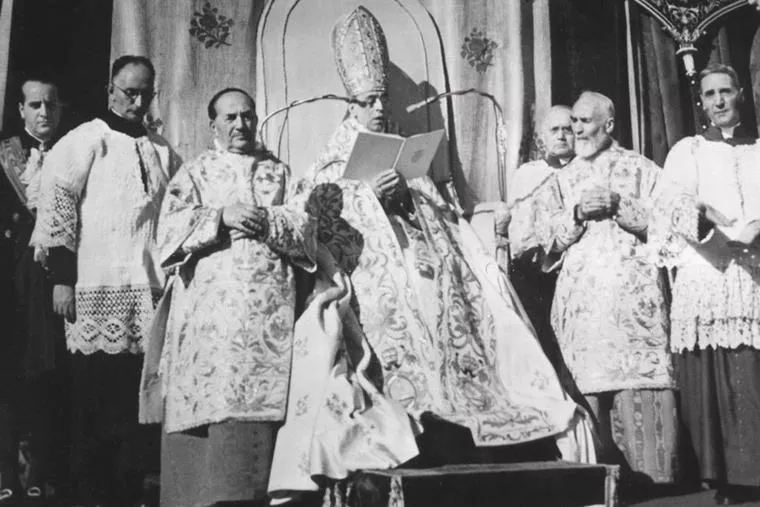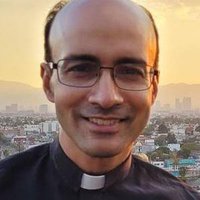
COMMENTARY: With her bodily glorification in heaven, Mary assumes the role of mother not just with regard to Christ, but towards all those who form part of the Church, the Mystical Body of Christ.
SIGN UP FOR OUR NEWSLETTER HERE
During another Jubilee Year 75 years ago, Pope Pius XII solemnly proclaimed the dogma of the Assumption. Pius XII — whom the Church now honors as “Venerable” in recognition of his heroic virtue — stated that at the end of her earthly life, Mary “was assumed body and soul into heavenly glory.”
Perhaps it can appear surprising that this key aspect of the life of Mary would be infallibly proclaimed at such an advanced moment in the Church’s history. The dogma of the Assumption has formed part of the common belief of pastors and the faithful from ancient times. At the same time, in formulating this doctrine, the Church has also come to recognize the deep significance that this teaching has for modern society.
Pius XII, who guided the Church through World War II and the beginning of the Cold War, perceived that the Church’s piety was ever vibrant, even amidst the advance of secularization and totalitarian ideologies. Blessed Pius IX’s pronouncement of the dogma of the Immaculate Conception, in 1854, had stirred up expectation among many that the Church might make a similarly solemn teaching about the end of Mary’s earthly life.
On May 1, 1946, less than a year after the end of the Second World War in Europe, Pius XII sent a letter to all the bishops of the world, asking them to inform the Holy See of the “devotion of your clergy and people … toward the Assumption of the most Blessed Virgin Mary” and whether they considered this belief might be defined as a dogma. Following an overwhelmingly favorable response, the Pope would go on to make the dogmatic declaration on Nov. 1, 1950, with the apostolic constitution Munificentissimus Deus.
In the elaboration of this dogma, we can recognize the living faith of the whole Church, which discerned the urgent need for a greater recourse to the Mother of God in the face of the various ills afflicting society. In light of such evils, the truth that Mary has been received into the glory of heaven, in both body and soul, is a powerful reminder of God’s loving plan for mankind, realized in the mystery of the Church.
As the liturgy proclaims in the Preface for the Solemnity of the Assumption, the Blessed Virgin’s entry into glory is “the beginning and image of your Church’s coming to perfection and a sign of sure hope and comfort to your pilgrim people.”
The same preface goes on to articulate the foundation for this privilege of the Mother of God: “Rightly you would not allow her to see the corruption of the tomb since from her own body she marvelously brought forth your incarnate Son, the Author of all life.”
As Pius XII comments in Munificentissimus Deus, the dogma of the Assumption is based on the intimate union between Mary and Jesus brought about by the mystery of the divine motherhood. It would seem “impossible,” he notes, to think of Mary, “the one who conceived Christ, brought him forth, nursed him with her milk, held him in her arms, and clasped him to her breast, as being apart from him in body, even though not in soul, after this earthly life.”
With her bodily glorification in heaven, Mary assumes the role of mother not just with regard to Christ, but towards all those who form part of the Church, the Mystical Body of Christ. As the French theologian René Laurentin stated, at the Assumption, Mary consciously took on the role of spiritual motherhood that she had first received at the Annunciation, which was formalized at the foot of the cross, and which became effective at Pentecost.
The early Christians readily acknowledged this motherhood. The first prayer to Mary that we know of, from a Greek manuscript thought to date from as early as the third century, expresses the earnest petition of the Church to the Mother of Christ under the title of Theotokos, commonly translated as “Mother of God.” By the fourth century, this term was broadly accepted by the faithful and was closely connected to the Council of Nicaea’s affirmation of Christ’s divine nature.
The Council of Ephesus would make its solemn teaching about the title only later, in the year 431, when the Patriarch Nestorius questioned the widely cherished invocation.
The Church’s ever-growing awareness of Mary’s unique identity would give rise to speculation about what happened at the end of her earthly life. The New Testament does not directly address this subject.
The curiosity of the faithful would receive an answer, although an imperfect one, in a set of pious writings known as the Transitus Mariae or “Transit of Mary.” These texts, while not historical, offer evidence of belief in the Assumption from at least the fifth century.
It was during the same century that the oldest Marian church in Jerusalem was constructed, upon the site of a first-century burial ground where the tomb of Mary was venerated. This empty resting place of the Blessed Virgin now forms part of the Church of the Sepulchre of St. Mary.
By the sixth century, the feast of the Dormition — a title that describes the same basic reality known in the Latin Church as the Assumption — had become well established in the Churches of the East. The belief about Mary’s final end is thus a significant point of agreement between Catholics and Orthodox. Christians of the ancient East had come to recognize, as Dominican Father Aidan Nichols points out, the importance of veneration of Mary as a means of safeguarding the true faith in Christ and in the Trinity against errors.
Maintaining this awareness of Mary’s exalted identity, the Church invokes her in the Hail Holy Queen hymn — which seems to have been used as early as the 11th century — as “our life, our sweetness, and our hope.”
Some Christians — for example, Martin Luther — have objected to such language. In light of such concerns, we should observe that such honor given to Mary is firmly directed to Christ. This traditional Marian prayer looks to Mary as a “most gracious advocate” before God, and confiding in her intercession directs us to the ultimate goal of the Christian life: “After this our exile, show unto us the blessed fruit of thy womb, Jesus.”
By virtue of the special privileges which Christ has wanted her to have, and by the singular power of her maternal mediation, Mary is truly our hope. In contemplating her, the Christian people are renewed in the certainty that sin and death will not have the last word.
The belief in Mary’s final glorification leads us to a more profound appreciation of the preeminent holiness that God has wanted to shine forth in her and which God also wants to be made manifest in his Church. In a world marked by materialism and moral corruption, as Pius XII teaches in his dogmatic declaration, the Assumption reminds us of the “lofty goal” to which all mankind is called in body and soul.
Therefore, the truth of Mary’s assumption is an article of faith that is ancient and yet at the same time highly fitting for the contemporary world. Strengthened by belief in this dogma, the Christian people can have the courage to “rejoice in hope” (Romans 12:12) without ignoring the serious difficulties faced by the Church and the world. For “in the Blessed Virgin,” as Pope Francis affirmed in convoking the current Jubilee Year, “we see that hope is not naive optimism but a gift of grace amid the realities of life.”
This article was originally published on National Catholic Register.

Opus Dei Father Joseph Thomas, based in Princeton, New Jersey, is dedicated to ministry that focuses on college students. He writes regularly on theological topics and is the author of The Theology of Divine Grace (Scepter, 2023). He also serves as the U.S. representative for the Pontifical University of the Holy Cross in Rome.







